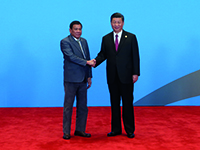In 2013 the Philippines brought a case before the Permanent Court of Arbitration (PCA) against China over territorial sovereignty and maritime rights in the South China Sea. Admittedly, they were successful before the court, but in the aftermath the tensions between both parties itensified dramatically - and no conflict resolution was in sight. Philippine President Duterte, inaugurated in 2016, assumed a new stance. He offered to ignore the court ruling for the time being, intensified economic relations and re-established bilateral communication channels.
In PRIF Report 3/2018 "Dealing With China in the South China Sea: Duterte Changing Course", Peter Kreuzer presents two lessons learned in dealing with China: first, that applying too much pressure through legal instruments may increase China's resistance and, second, that China's behavior can be influenced through strategies that respond positively to the country's core needs and predicaments.
